Minter Dial's Blog: Minter Dialogue, page 68
December 20, 2017
How To Build A Great LinkedIn Network And Why Reducing Your LinkedIn Network May Be Key
I have to guess that, since you’re reading this post, you’re on LinkedIn? I also imagine that, like me, you wonder how worthwhile your LinkedIn network actually is? Maybe you have garnered a rather large network and you battle with the quandary of accepting or not new invitations? The problem: is LinkedIn working for you? Is your network on LinkedIn a fitting reflection of who you are? Is it a network you can rely on? Is it a trustworthy selection of the best of your business-related acquaintances? Do you know why/how you are connected with each member?
If the answer to any of the questions is no, then we surely have work to do.
Strengthening Your LinkedIn Network
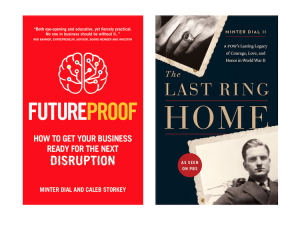
Futureproof and The Last Ring Home
Over the past twelve months, if you haven’t noticed, I have been in a deep production mode. In that window, I released a film and published two books (The Last Ring Home and Futureproof). This led me to organize around 60 events, specifically to screen my film and/or do book readings. Over that time, I’ve done events in nineteen cities in four countries. In so doing, as any author knows, you end up having to push like a madman to get your friends and family to support you, to put “bums in seats” and to sell books. I note that it’s quite ungratifying that, after completing a book, you need to flog it, too. Anyway, as a result, I’ve had to use my various “social” networks to help push and promote. Many of you may have been on the receiving end of my multiple missives. For the most part, my communications were via group emails or posts on Facebook, LinkedIn, Google+ and Twitter. I also resorted to the occasional burst of individualized, personal messages, whether via email, LinkedIn or Facebook Messenger. Without doubt, the personal messages would get the biggest responses. Surprisingly, though, many recipients of these individualized messages — many of whom I know very well — never replied. This got me thinking…
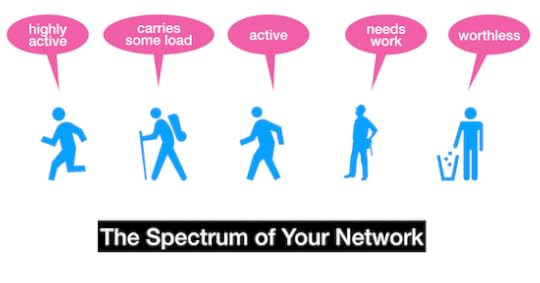
Who’s reliable in my network? Who are the linchpins and who are the deadweights? From right to left, maybe I should start classifying my Linkedin network? After all, surely it would be better to have a smaller strong group than a diffuse and unreliable large group of connections?
Vanity might push us to push for / accept many invitations, but a LinkedIn network is only as good as it is active. #linkedin #network
You Are Your Network
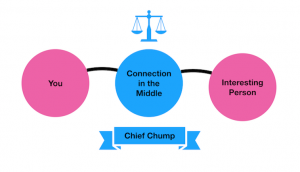 What good is a connection if he/she doesn’t ever respond to your personal message? If you go to the effort to write something specifically to them, but they don’t react, I have to believe they don’t represent any value. Perhaps they’re too busy. Perhaps they are overloaded with messages. Perhaps they feel that they’ve got other things to do with their time. Of course, it’s always possible that my solicitation was too irksome! But in any event, if you can’t reach out to your network for a favor, a question, advice or just to see if there’s a heartbeat on the other end, it certainly gives pause to think. In light of the number of non-responses for individual messages I have sent out over the last year — essentially asking people in geographic locations, if they’d like to attend the screening of my documentary film — I have come to believe that a good cull would be worthwhile. It’s not as if the large number of connections is a sign of any importance. The only benefit on LinkedIn of having a large network is sometimes being identified as a second-tier connection with other interesting individuals. But, if the person linking you is a dud (aka “Chief Chump”), I would tend to believe the person on the other side of the link thinks so, too.
What good is a connection if he/she doesn’t ever respond to your personal message? If you go to the effort to write something specifically to them, but they don’t react, I have to believe they don’t represent any value. Perhaps they’re too busy. Perhaps they are overloaded with messages. Perhaps they feel that they’ve got other things to do with their time. Of course, it’s always possible that my solicitation was too irksome! But in any event, if you can’t reach out to your network for a favor, a question, advice or just to see if there’s a heartbeat on the other end, it certainly gives pause to think. In light of the number of non-responses for individual messages I have sent out over the last year — essentially asking people in geographic locations, if they’d like to attend the screening of my documentary film — I have come to believe that a good cull would be worthwhile. It’s not as if the large number of connections is a sign of any importance. The only benefit on LinkedIn of having a large network is sometimes being identified as a second-tier connection with other interesting individuals. But, if the person linking you is a dud (aka “Chief Chump”), I would tend to believe the person on the other side of the link thinks so, too.
Here’s my bottom line: A strong LinkedIn network means having individuals with whom are active. They engage with you, will ask questions or share ideas/posts. They might ask you for a service from time to time, but in general they are happy to respond, like and comment with you. Otherwise, what worth are they other than a node on some computer map.
If you can’t bother to reply to your connection’s private messages, then you’re not worth being connected to! #linkedinnetwork
My request to @LinkedIn: help each of us to identify the active people in your network. I’d ideally like to be able to identify automatically those people who never replied to any message you’ve sent out. That way you can choose to eliminate deadwood.
Your thoughts and reactions?
The post How To Build A Great LinkedIn Network And Why Reducing Your LinkedIn Network May Be Key appeared first on Myndset.
December 17, 2017
Using Artificial Intelligence to Create Great Content, With Martin Adams CEO of Codec.AI (MDE261)

Minter Dialogue with Martin Adams
Martin Adams is CEO & Co-Founder @ Codec, a platform using AI to help produce content and drive content marketing. Martin is also a speaker on innovation, AI and the blockchain. In this conversation, we look at how Martin has gone about using AI for his business and what tips and tricks there are for any business looking to do the same. We also look at the content marketing situation and what are some best practices for today’s marketers.
Below, you’ll find the show notes and, of course, you are invited to comment. If you liked the podcast, please take a moment to go over to iTunes to rate the podcast.
To connect with Martin Adams:
You can find Martin on Twitter: @Martin_D_Adams
Martin Adams on Linkedin
————–
Further resources for the Minter Dialogue Radio Show:

Meanwhile, you can find my other interviews on the Minter Dialogue Radio Show in this podcast tab, on Buzzsprout or via iTunes. Please don’t be shy about rating this podcast on iTunes here!
Music credit: The jingle at the beginning of the show is courtesy of my friend, Pierre Journel, author of the Guitar Channel. And, the new sign off music is “Finger Paint,” written and performed by Josh Saxe, produced by Chase Geiser. Here’s a link on iTunes. I invite you to take a spin on Pierre’s podcast or listen to more of Josh’s music!
The post Using Artificial Intelligence to Create Great Content, With Martin Adams CEO of Codec.AI (MDE261) appeared first on Myndset.
December 13, 2017
The Key Trends For 2018 – Brace Yourself
Are you concerned about or interested by what is going to happen in 2018?
In the era of too much (spurious and fake) news, it’s a serious challenge for business leaders to stay abreast of what’s going on. At one level, it’s hard enough to keep up with what’s going within one’s own industry. But, with the threat often coming from without the industry, the challenge is decidedly bigger. Another reality for most business leaders is that EVERYONE has read about the vast amount of new technologies. Some, like social media and smartphone, have been around for over a decade. It’s easy to be complacent about these. Yet, even they will require a new eye and adapted strategies in the new year.
Key Trends for 2018
Here are the seven key trends – new tech and others — that will pepper if not dominate 2018. For sure, it will be another rock’n’roll year, becasuse:
It’s Only Going To Get Worse. The pace. The amount of communications. The stress. The pressure on results. Key thought: The illusory idea that things will get better can only be preceded by a profound strategic choice to do so.
Digital Transformation Projects Will Be About Execution. Now that everyone has embarked on some form of transformation project, 2018 will be about results. Is your digital transformation programme turning the corner and creating lasting change? Key thought: If the board of directors hasn’t change their way of operating, it’s unlikely your transformation will come quickly enough.
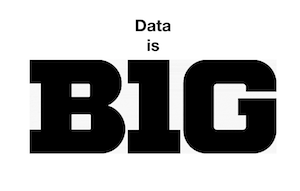 Data Will Get Big. As the ability to analyze improves, thanks in large part to progress in AI and better data scientists, companies will finally cotton on to the BIGGER need to bulk up their data. It’s better to have big data and less sophisticated computer systems than it is to have little data and high-end systems. Key thought: Explore all the ways you can find and combine data on your market and your customers.
Data Will Get Big. As the ability to analyze improves, thanks in large part to progress in AI and better data scientists, companies will finally cotton on to the BIGGER need to bulk up their data. It’s better to have big data and less sophisticated computer systems than it is to have little data and high-end systems. Key thought: Explore all the ways you can find and combine data on your market and your customers.Artificial Intelligence Will Smarten Up. The pace of investment in artificial intelligence has accelerated, led by the big tech companies in the US and China. According to market research firm Tractica, “AI spending is forecasted to grow from $640MM in 2016 to $37B by 2025.” For big business, the application of AI, much like “digital” in general, must be focused on supporting the strategic imperatives of the company. Key thought: Where is your AI expertise? If it’s not inside the company, you might need to revisit that vacuum quickly.
Marketing Will Continue to Morph. This year, we saw that it’s become a pay-to-play game in content marketing. It’s not just a problem of too much information. I expect to see marketing automation proliferate and, unfortunately, worsen in use. Many companies continue to resort to highly paid celebrity spokespeople or, worse, trickery and devious tactics to make their content and brand name get out there. In 2018, we should expect the consumer to be ever more weary of improper, unethical techniques. Short cuts — like throwing money at celebrities or influencers — may continue to provide vanity statistics, but the brands that are doing the hardwork of answering the real FAQ and providing genuine information, useful educational content or original entertainment will be the winners long term. Key thought: How are you finding and working the data for insights to help you craft the best content?
The Breakout Year of Voice. In combination with the advancement in AI of course, but the democratization of voice-controlled machines in the home will have a disruptive effect on many industries. If in 2016, 20% of mobile search was generated by voice, Google says that “[b]y 2020, voice commands will make up 50% of all searches.” Key thought: For those creating content, it will no longer be enough to be mobile friendly or mobile first. SEO will become VSO – Voice Search Optimization. And for this, context will be instrumental.
Cyber Security Boon. Of all the technologies cited in our book, Futureproof, the sector with the largest dollar figure associated with it is inevitably cyber security. That’s because of two things: (1) the big rush by companies to invest in securing their systems, and (2) the inevitability and cost of having more cyber security breaches. Key thought: As we have always maintained, your weakest link is and will remain the human being. What ongoing learning are you providing in your organization to help individuals to avoid falling into the next best phishing trap?
I am not bold or crazy enough to call out any major changes among the new tech players. But I do think that consolidation is bound to happen among the social media companies. This is because of a combination of consumer social media fatigue and struggling business models (Snap, Twitter…). If there is no stock market crash, I would expect a good deal more M&A activity. Digitally enhanced marketing activities such as influencer marketing and tech using augmented reality (esp for retail and eCommerce) will continue to grow leaps and bounds.
Meanwhile, just as Caleb and I developed in our book, Futureproof, I expect to see continued exploration and advancements in several other key new technologies, such as the Blockchain, Genomics, Self-Driving Cars, Energy Storage and 3D printing. On the other hand, I do not think that Bitcoin or Virtual Reality will be a big topic for big business in 2018.
My final call: don’t fall asleep at the wheel with your mobile or web strategy. The User Experience will continue to evolve and those out-of-date or unfriendly experiences will penalize your business.
Your thoughts and reactions about the key trends for 2018 are, of course, welcome!
The post The Key Trends For 2018 – Brace Yourself appeared first on Myndset.
December 12, 2017
The Unsubscribe User Experience – The Boss Won’t Ask You This Question…
Email marketing remains one of the main pillars of any normal marketing strategy. It still provides a great Return on Investment considering the cost per communication, even if open rates for mass marketers often toil to get over 2%. Regulations continue to evolve, no more so than in Europe with upcoming new General Data Protection Regulation (GDPR). But, an area that has always fascinated me is the UNSUBSCRIBE element of newsletters. And it’s a question that no boss will even WANT to ask: How easy is it for someone to unsubscribe from our newsletter? Many companies seem to go to great lengths to make unsubscribing as difficult as possible. Having just gone through a veritable spring cleaning of unnecessary newsletters in my inbox, I got a chance to check out how brands are managing the unsubscribe function.
This list looks at some more or less egregious tactics:
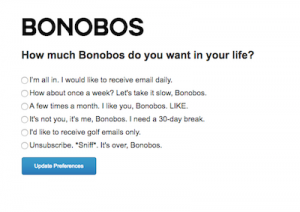
Bonobos (now part of Walmart) asks with a bit of humor to stay in touch
no option whatsoever to unsubscribe (e.g. LadenburgThalmann Research) NB I never signed up with them in the first place
an unsubscribe button that tricks you into signing up again (e.g. Twoo)
create multiple steps/clicks
worse yet, the need to sign in to your account in order to change subscription, so you need to go find your login and password (e.g. Sephora [part of LVMH], The Times)
very small print hidden in the bottom footer (many)
reduced visibility color for the word (many)
one last pop up to “make sure” (e.g. La Redoute, Product Hunt)
provide lesser options such as less frequency (e.g. Bonobos does this with a sense of humor – see right)
don’t create a mobile friendly version (e.g. OpenMarket – see below)
…
And it doesn’t end there. Many sites will force upon unsubscribers one last visit to their site, in the hopes that it will make them regret their unsubscription or, better yet, make one last purchase. Others will send a last “sorry to see you go” mail in the hopes that it was just a mistake “by someone to whom you had forwarded the newsletter.” (e.g. The Hub Institute).
Should You Have A One-Click Easy Unsubscribe?
Is a One-click Unsubscribe the best solution? In this post by a titan of digital marketing, Jeff Bullas swears away from making it that easy to unsubscribe or you may risk losing by mistake “a hard-earned subscriber” (see point #4 in his post). It’s a fine balance between making it user-friendly and adding that little bit of friction. It’s true that some people might hit the button by error on a small mobile interface. Having a second step that either asks why you are unsubscribing or just to confirm your selection is a decent and acceptable option. Afterwards, if you ask why they are unsubscribing, the question is: what do you do with that data?
Bottom line: Unsubscribe is still part of the user experience. If you believe that you need to stop the bleeding at the unsubscribe moment, you clearly have not done your homework upstream. Of course, it’s fair to ask a question as they go, etc., but a brand just can’t hope that, by making it hard, it will win over their customer.
The ONLY appropriate tactic is to make killer content that the subscriber will be thankful you sent them. #unsubscribetobadcontent #emailmarketing
Examples of UNSUBSCRIBE User Experiences
Below are just a few other examples of the different unsubscribe user experiences, more or less trying to keep the subscriber from unsubscribing too easily.
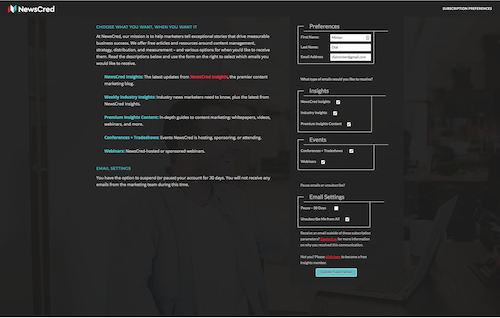
NewsCred (you need to look down on the bottom right)

OpenMarket mobile version… you need to scroll down the unnecessary blank space
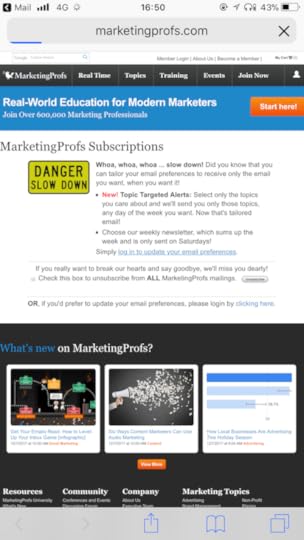
MarketingProfs gives a DANGER warning and an option to reduce, not just unsubscribe
Happy to hear your point of view or about other techniques for the unsubscribe user experience?
The post The Unsubscribe User Experience – The Boss Won’t Ask You This Question… appeared first on Myndset.
December 10, 2017
Artificial Intelligence + Data Ownership + New Business Model with Nick Oliver at People.Io (MDE260)
 Nick Oliver is an entrepreneur, looking at the cross section of artificial intelligence, personal data ownership and business models. He’s the founder and CEO of people.io, a start-up whose purpose is giving people ownership of their data. People.io is described as a firewall for people. In this conversation, we discuss Nick’s remarkable background, the inspiration behind and the development of People.Io and the challenge of developing trust. It’s an innovative idea and a fascinating story.
Nick Oliver is an entrepreneur, looking at the cross section of artificial intelligence, personal data ownership and business models. He’s the founder and CEO of people.io, a start-up whose purpose is giving people ownership of their data. People.io is described as a firewall for people. In this conversation, we discuss Nick’s remarkable background, the inspiration behind and the development of People.Io and the challenge of developing trust. It’s an innovative idea and a fascinating story.
“Giving people ownership of their data” @nicoliver86 @people_io
Below, you’ll find the show notes and, of course, you are invited to comment. If you liked the podcast, please take a moment to go over to iTunes to rate the podcast.
To connect with Nick Oliver:
You can find Nick Oliver on Twitter: @nicoliver86
Nick on Linkedin
His eponymous site: Nicholas Oliver
You can send an email to Nick Oliver here
Download the people.io app in iTunes
Sites mentioned by Nick:
Jaron Lanier – Who Owns The Future
————–
Further resources for the Minter Dialogue Radio Show:

Meanwhile, you can find my other interviews on the Minter Dialogue Radio Show in this podcast tab, on Buzzsprout or via iTunes. Please don’t be shy about rating this podcast on iTunes here!
Music credit: The jingle at the beginning of the show is courtesy of my friend, Pierre Journel, author of the Guitar Channel. And, the new sign off music is “Finger Paint,” written and performed by Josh Saxe, produced by Chase Geiser. Here’s a link on iTunes. I invite you to take a spin on Pierre’s podcast or listen to more of Josh’s music!
The post Artificial Intelligence + Data Ownership + New Business Model with Nick Oliver at People.Io (MDE260) appeared first on Myndset.
December 5, 2017
Why Spelling Mistakes And Grammar Errors (Are Different And) Both Count!
Considering most computers come with spell checkers, it seems hard to imagine how an important document can ever have spelling mistakes. Not that my blog — with over 1300 posts — or my books are without mistakes, but when you have a customer-facing printed piece with a very limited number of words, you have to imagine that spelling mistakes are easier to catch. This London-based fusion Lebanese-French restaurant, L’Oud Des Eurasie, created a menu with no less than 8 mistakes on these two pages below, and I’m not including the inconsistent lower- and uppercase words (grammar). The biggest howler for me is “Potatoe.” Moreover, even the name of the restaurant is a spelling mistake. It ought to be either L’Oud Des Eurasies or L’Oud De l’Eurasie. For an establishment that claims to be premium, sloppy work is a surefire sign that they won’t make it.

As you can see, the spelling mistakes are more or less egregious. Even if the fare was good and the service (by one man) was fine, the lack of attention to detail made me pause to think (and provoked this post, of course). Finally, I’ll add that the wifi might have been free, but it didn’t work.
The cost of spelling mistakes
So, is there a cost to spelling badly or having poor grammar? I think there are three potential costs:
Customers who notice the mistakes can’t be impressed, even if they don’t say anything. There’s even the risk that they may get confused. I would argue that the establishment is losing some — if small — element of trust.
When the staff are repeatedly informed by customers, the internal eye-rolling is no good for staff morale.
If you can’t spell, you yourself may become a victim… of worse things.
The third point is the most counter-intuitive, but let me explain. Here’s the deal: If you can’t spell, you are vulnerable. Specifically, many spammers and hackers seem to suffer spelling deficiencies, so if you can’t detect the mistakes you may fall prey to a hack. Below is a phishing attempt, purportedly from Apple, that I received recently. As users/consumers, we need to be able to recognize the difference between legitimate and fake messages.

This Apple phishing message continues similar mistakes to the menu above: 2 glaring spelling mistakes, inconsistent lower- and uppercase (Unlock ID, Billing Information…). Also, I would argue that the letter K in the word “Locked” is wrong. This seems to be a peculiar font set, but the K is a mini uppercase in the opening title, whereas it ought to be lowercase. As far as I’m concerned, this would be a clue that the hackers have a Cyrillic keyboard. And, in terms of English, it’s quaint that the second sentence really means what it means. “We need to verify [read: get] your account information in order [for us, hackers] to continue using your account ID.
If you, as a legitimate brand, are including spelling and grammar mistakes, you’re no better than a sloppy hacker!
Bottom line:
Despite all the SMS short-form messages and emoticons, it still counts to know how to spell and write correctly.
The post Why Spelling Mistakes And Grammar Errors (Are Different And) Both Count! appeared first on Myndset.
December 3, 2017
Founding A Bona Fide Culture of Continuous Learning with Magoo Giles (MDE259)
 Magoo Giles is the founder, director and chief storyteller (my words) at The Knightsbridge School, in the heart of London. In this conversation with the entertaining Magoo, we discuss role models, how he came to found the school, how one creates and instills a legitimate and sustainable culture, and how to manage the challenges that any entrepreneur faces when hiring individuals, making the values come alive or even passing on the reins.
Magoo Giles is the founder, director and chief storyteller (my words) at The Knightsbridge School, in the heart of London. In this conversation with the entertaining Magoo, we discuss role models, how he came to found the school, how one creates and instills a legitimate and sustainable culture, and how to manage the challenges that any entrepreneur faces when hiring individuals, making the values come alive or even passing on the reins.
Below, you’ll find the show notes and, of course, you are invited to comment. If you liked the podcast, please take a moment to go over to iTunes to rate the podcast.
To connect with Magoo Giles:
Magoo Giles on Linkedin
Visit Magoo at Mgu World
Site mentioned by Magoo:
Visit Lulu to find Magoo’s book
————–
Further resources for the Minter Dialogue Radio Show:

Meanwhile, you can find my other interviews on the Minter Dialogue Radio Show in this podcast tab, on Buzzsprout or via iTunes. Please don’t be shy about rating this podcast on iTunes here!
Music credit: The jingle at the beginning of the show is courtesy of my friend, Pierre Journel, author of the Guitar Channel. And, the new sign off music is “Finger Paint,” written and performed by Josh Saxe, produced by Chase Geiser. Here’s a link on iTunes. I invite you to take a spin on Pierre’s podcast or listen to more of Josh’s music!
The post Founding A Bona Fide Culture of Continuous Learning with Magoo Giles (MDE259) appeared first on Myndset.
November 28, 2017
Is Your Business Disruption-Proof? How To Futureproof Your Business
I was on a plane the other day and was quite amused to hear my neighbour, a fairly senior executive in his early 40s, suggest that his company (in fact, his industry) was actually protected from disruption.
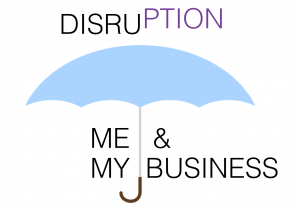
The industry in question was Insurance and the player in question was a very large player on mainland Europe. I thought to myself: How on earth does someone in 2017 even dare to think that they are immune to disruption? Granted there are some sectors that have more natural defence mechanisms than others, such as the manufacturer of nuclear power plants, super luxury airplanes and yachts, antique clock repairs… But, for ordinary consumer facing and/or broad-based B2B businesses, the concept of being disruption-proof seemed a deep folly. For me, they are definitely at risk, especially with such a mindset.
What does it take to have a disruption-proof business?
As far as I’m concerned, it’s hard to say that any business or sector will be impervious to the disruptive forces at large. These include the changing nature of the customer, as well as the onslaught of new and powerful technologies. Moreover, more new tech is coming down the pipe that might cause even greater paradigm shifts. If there is little hope of being truly disruption-proof, I can admit there are certainly some characteristics that will help assuage or possibly delay disruption. This would include if your business….:
has only a handful of (potential) clients
is extremely specialized
is geographically remote/inaccessible
is in ultra-hyper luxury
involves government defenses
…
Then again, none of these characteristics is a guarantee. Even being regulated is no guarantee. In a pre-Internet world, the disruptive mindset of Richard Branson’s Virgin certainly proved many seemingly “protected” industries wrong.
A veneer of protection
Naturally, when you look at the taxi business, you could imagine why taxi drivers thought that the medallion/license would have protected them. If you’re a hotel business, you might be excused in thinking that the capital intensive nature of building and running hotels would be an adequate barrier. But today, having an exceptional product or established long-term relationships with customers is just not enough to hold off the disruptive forces out there… It all amounts to a veneer of protection.
What makes for your being disruption-prone?
Taking a cue from the customers’ perspective, sectors that seem to enjoy oversized power and control are likely creating large margins and many unhappy customers. Here are just some of the characteristics that make a sector a good candidate for real disruption:
unhappy customers
customers who feel tied up involuntarily
too many intermediaries
price opacity
poor user experience
bad customer service
…
So is he right? Is the Insurance sector disruption-proof?
Yes, the Insurance sector has a degree of specialization and regulation. And, like many of the financial services sectors, the threat of an entire overhaul from a fintech is probably quite overblown, at least in the short-term. Fintech companies are often ill-equipped to be valiant, much less valid, competitors. Moreover, many banks are contenting themselves with a strategy of acquisition to either partner or subdue pesky startups. Many of the digital-only banks that are cropping up are only taking small slivers of business. Robo advisors still only have a marginal market share of the financial advisor business. Artificial intelligence has a long way to go to replace private advisors for the ultra wealthy. But, in insurance, where the relationship between customer and supplier is cold, undifferentiated and fraught with small print “nuisances”, the opportunity for alternative services to crop up seem legion.
If I were in the insurance business, here are a few examples of things I’d be worried about:
when Amazon and Google get into our homes and know more about our internal possessions and habits…
when Facebook, phone makers and telcos are able to evaluate our risk factors better…
when technologies like social media and genomics allow for a much more accurate reading of customer needs and risks
when startups pick off little parts of the business that matter (ex: Wrisk that provides insurance in a transparent manner according to your exact needs as opposed to a blanket/banal coverage… )
when transparency — aided by AI — undermines the fat margin contracts that systemically continue to exist
…
Bottom line: I don’t believe anyone is disruption proof. Even trying to become futureproof is a journey, not a guarantee of long-term success, by any means. The first point I’d say is that you need to be rather obsessively thinking about why your business will be disrupted as opposed to hoping that yours is protected. Sure you might be able to buy your way out of some jams, but ultimately, you had better adopt a mindset that says: change is for sure, growth is the option.*
*Quote from my friend Sam Villa
The post Is Your Business Disruption-Proof? How To Futureproof Your Business appeared first on Myndset.
Is My Business Disruption-Proof? How To Futureproof Your Business
I was on a plane the other day and was quite amused to hear my neighbour, a fairly senior executive in his early 40s, suggest that his company (in fact, his industry) was actually protected from disruption.

The industry in question was Insurance and the player in question was a very large player on mainland Europe. I thought to myself: How on earth does someone in 2017 even dare to think that they are immune to disruption? Granted there are some sectors that have more natural defence mechanisms than others, such as the manufacturer of nuclear power plants, super luxury airplanes and yachts, antique clock repairs… But, for ordinary consumer facing and/or broad-based B2B businesses, the concept of being disruption-proof seemed a deep folly. For me, they are definitely at risk, especially with such a mindset.
What does it take to have a disruption-proof business?
As far as I’m concerned, it’s hard to say that any business or sector will be impervious to the disruptive forces at large. These include the changing nature of the customer, as well as the onslaught of new and powerful technologies. Moreover, more new tech is coming down the pipe that might cause even greater paradigm shifts. If there is little hope of being truly disruption-proof, I can admit there are certainly some characteristics that will help assuage or possibly delay disruption. This would include if your business….:
has only a handful of (potential) clients
is extremely specialized
is geographically remote/inaccessible
is in ultra-hyper luxury
involves government defenses
…
Then again, none of these characteristics is a guarantee. Even being regulated is no guarantee. In a pre-Internet world, the disruptive mindset of Richard Branson’s Virgin certainly proved many seemingly “protected” industries wrong.
A veneer of protection
Naturally, when you look at the taxi business, you could imagine why taxi drivers thought that the medallion/license would have protected them. If you’re a hotel business, you might be excused in thinking that the capital intensive nature of building and running hotels would be an adequate barrier. But today, having an exceptional product or established long-term relationships with customers is just not enough to hold off the disruptive forces out there… It all amounts to a veneer of protection.
What makes for your being disruption-prone?
Taking a cue from the customers’ perspective, sectors that seem to enjoy oversized power and control are likely creating large margins and many unhappy customers. Here are just some of the characteristics that make a sector a good candidate for real disruption:
unhappy customers
customers who feel tied up involuntarily
too many intermediaries
price opacity
poor user experience
bad customer service
…
So is he right? Is the Insurance sector disruption-proof?
Yes, the Insurance sector has a degree of specialization and regulation. And, like many of the financial services sectors, the threat of an entire overhaul from a fintech is probably quite overblown, at least in the short-term. Fintech companies are often ill-equipped to be valiant, much less valid, competitors. Moreover, many banks are contenting themselves with a strategy of acquisition to either partner or subdue pesky startups. Many of the digital-only banks that are cropping up are only taking small slivers of business. Robo advisors still only have a marginal market share of the financial advisor business. Artificial intelligence has a long way to go to replace private advisors for the ultra wealthy. But, in insurance, where the relationship between customer and supplier is cold, undifferentiated and fraught with small print “nuisances”, the opportunity for alternative services to crop up seem legion.
If I were in the insurance business, here are a few examples of things I’d be worried about:
when Amazon and Google get into our homes and know more about our internal possessions and habits…
when Facebook, phone makers and telcos are able to evaluate our risk factors better…
when technologies like social media and genomics allow for a much more accurate reading of customer needs and risks
when startups pick off little parts of the business that matter (ex: Wrisk that provides insurance in a transparent manner according to your exact needs as opposed to a blanket/banal coverage… )
when transparency — aided by AI — undermines the fat margin contracts that systemically continue to exist
…
Bottom line: I don’t believe anyone is disruption proof. Even trying to become futureproof is a journey, not a guarantee of long-term success, by any means. The first point I’d say is that you need to be rather obsessively thinking about why your business will be disrupted as opposed to hoping that yours is protected. Sure you might be able to buy your way out of some jams, but ultimately, you had better adopt a mindset that says: change is for sure, growth is the option.*
*Quote from my friend Sam Villa
The post Is My Business Disruption-Proof? How To Futureproof Your Business appeared first on Myndset.
November 26, 2017
Driving Digital Transformation at the BBC with Dmitry Shishkin (MDE258)
 Dmitry Shishkin is Digital Editor at the BBC World Service, shaping the evolution of the famed BBC World Service in the digital age. He’s also overseeing the languages digital product requirements, helping the expansion into the strategic “need” and “want” markets. At the coal face of the impact of digital on media, Dmitry also helps the editorial teams react and adjust to the changing consumptions patterns. In this conversation, we discuss how he has managed and influenced change at the BBC, how important it is to lead by example, all the while learning and experimenting along the way. A fascinating journey.
Dmitry Shishkin is Digital Editor at the BBC World Service, shaping the evolution of the famed BBC World Service in the digital age. He’s also overseeing the languages digital product requirements, helping the expansion into the strategic “need” and “want” markets. At the coal face of the impact of digital on media, Dmitry also helps the editorial teams react and adjust to the changing consumptions patterns. In this conversation, we discuss how he has managed and influenced change at the BBC, how important it is to lead by example, all the while learning and experimenting along the way. A fascinating journey.
Below, you’ll find the show notes and, of course, you are invited to comment. If you liked the podcast, please take a moment to go over to iTunes to rate the podcast.
To connect with Dmitry Shishkin:
You can find Dmitry on Twitter:@dmitryshishkin
Dmitry Shishkin on Linkedin
————–
Further resources for the Minter Dialogue Radio Show:

Meanwhile, you can find my other interviews on the Minter Dialogue Radio Show in this podcast tab, on Buzzsprout or via iTunes. Please don’t be shy about rating this podcast on iTunes here!
Music credit: The jingle at the beginning of the show is courtesy of my friend, Pierre Journel, author of the Guitar Channel. And, the new sign off music is “Finger Paint,” written and performed by Josh Saxe, produced by Chase Geiser. Here’s a link on iTunes. I invite you to take a spin on Pierre’s podcast or listen to more of Josh’s music!
The post Driving Digital Transformation at the BBC with Dmitry Shishkin (MDE258) appeared first on Myndset.
Minter Dialogue
- Minter Dial's profile
- 14 followers



